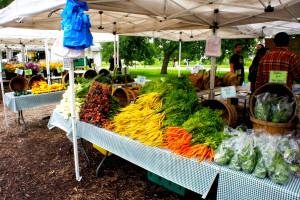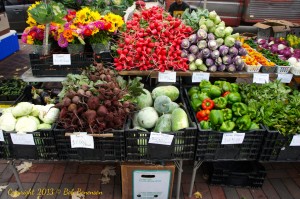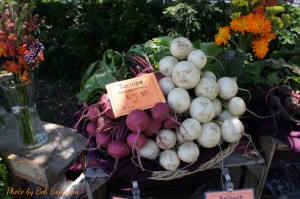by Sustainable Food News, guest contributor
This article, initially published Aug. 3 by Sustainable Food News, is republished with permission. Sustainable Food News, based in Portland, Maine, provides daily coverage of developments important to those with interests in the Good Food movement. For more information or to subscribe, please visit Sustainable Food News’ website.
This week (Aug. 2-8) is National Farmers Market Week, as officially proclaimed by the U.S. Department of Agriculture. To mark the occasion, Good Food on Every Table on Aug. 3 published an article about how consumers can save money while shopping at farmers market. To read that article, please click here.
The U.S. Department of Agriculture kicked off the 16th annual Farmers Market Week Sunday, announcing a 64 percent increase in customer traffic in markets open for at least two years.
The figure comes from results of the 2014 Farmers Market Manager Survey, released Friday and based on a survey of almost 1,400 farmers market managers.
The results showed that virtually all market managers surveyed sold locally grown fresh fruits or vegetables at their markets, and that 66 percent had at least one USDA-certified organic vendor.
USDA Secretary Tom Vilsack said the nation’s more than 8,400 farmers markets “benefit communities by offering healthy, wholesome food, while local farmers and ranchers benefit from new ways to present their products to customers.”
For example, in New Mexico, the Santa Fe Market operates three times a week and draws as many as 5,000 visitors a day during its peak season. It is also one of more than 6,400 farmers markets across the country that accept Supplemental Nutrition Assistance Program (SNAP) benefits as payment.
The survey found that about 64 percent of farmers markets reported increases in the number of repeat customers and increases in year-on-year sales. And, 85 percent of market managers wanted to add vendors, with 62 percent looking for vendors selling different types of products.
Market managers did not perceive competition between farmers markets as a serious threat to market sales, according to the survey. In addition, 81 percent of farmers markets feature healthier eating programs, such as distributing healthy-recipe cards to customers and sponsoring healthy-themed cooking demonstrations.
Farmers markets boost SNAP
About 75 percent of farmers markets have at least one vendor accepting federal nutrition assistance as payment. Programs such as SNAP; the Women, Infants, and Children Farmers Market Nutrition Program (WIC FMNP); and the Senior Farmers Market Nutrition program (SFMNP) expand the customer base for farmers, give recipients access to healthy foods, and encourage the sale of locally-sourced produce.
Other results from the survey include:
• 75 percent of markets use volunteers to perform market operations, and 46 percent choose volunteers as managers. Nearly half of market managers offer special programs or opportunities, and most provided market space for special events.
• About 21 percent of farmers markets helped incubate new agribusinesses by sharing facilities and retail space and/or providing technical assistance. Nearly a quarter of farmers markets were used as a delivery point for community supported agriculture (CSA) enterprises.
• 84 percent of farmers market managers used Web and/or mobile-based technologies to communicate with customers, vendors, and their communities.
USDA’s Know Your Farmer, Know Your Food (KYF2) initiative coordinates USDA’s local food efforts. In the past two years alone, USDA has made over 500 investments in food hubs, local processing facilities, and distribution networks.
The USDA’s Agricultural Marketing Service (AMS) supports farmers markets through grants, research, and technical assistance. Last year, AMS awarded $26.6 million in competitive grants though the Farmers Market and Local Food Promotion Program.
AMS also manages the National Farmers Market Directory, one of four USDA Local Food Directories that provide customers with online access to locations, hours, and other information about farmers markets, community supported agriculture enterprises, food hubs, and on-farm markets.




